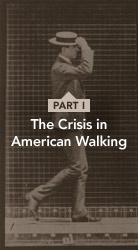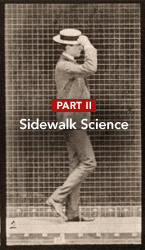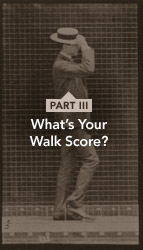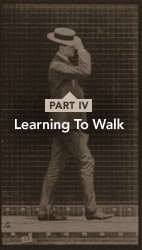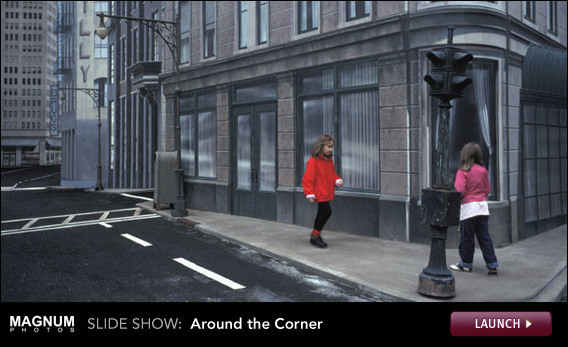Sidewalk Science
The peculiar habits of the pedestrian, explained.
What does famed urbanist William “Holly” Whyte have in common with David Simon’s award-winning television series The Wire?
They both understood the importance of street corners. On The Wire, drug slingers battle for control of Baltimore’s choicest retail outlets; “them corners” offer strategic advantage: double the traffic, better sightlines, more escape routes, and the presence of businesses, magnets for potential customers.
Several decades earlier, Whyte, in his films of New York City street life, identified the street corner as an important factor in urban dynamics. Here was a zone of serendipity where people encountered one another beneath the blinking walk man, where they paused to chat before parting, where they formed small convivial islands just as pedestrian flow was surging most strongly. Even today, corners offer new uses; one often finds people talking there on their mobile devices, either held up by the signal or forgetting to move after the signal has changed. Either way, the corner is urban punctuation, a place to pause, essential to the whole civic grammar.
And so it’s appropriate that Jeff Zupan and I are stopped on a New York corner—at 34th and Broadway—watching how pedestrians navigate a typical crowded crosswalk. In 1975 Zupan wrote (with Boris Pushkarev), one of the seminal books on how people move on foot in cities, Urban Space for Pedestrians. Although he now lives in the suburbs, his ardor for the bipedal New Yorker is undiminished. At one point, after walking a while, I offer to buy him a drink at a sidewalk stand. He bristles. “I don’t patronize food carts,” he says. The reason? They take up sidewalk space on already crowded thoroughfares. Outside of 30 Rockefeller Plaza, he pauses briefly to berate a tour bus driver, whose empty bus sits idly, its engine sending a noisy blast of hot air onto the sidewalks. The driver briefly looks up from his New York Post and, sensing no immediate physical threat, resumes reading.
I have gone out today on a stroll with Zupan in the tradition of the Peripatetics, those ancient Greek scholars who were said, perhaps apocryphally, to accompany Aristotle on walking lectures. My purpose is to study the pedestrian in his natural setting (the most-walked city in the U.S.) and to bring to light the discrete dynamics that lie beneath this achingly commonplace activity—which, like most commonplace activities, rewards a further look. Zupan, my Aristotle, represents a bridge to the past, when the best way to understand how people moved on foot was to watch them; an approach that has been slowly eclipsed by computer modeling, which automatically counts pedestrians in large flows, tracks their movements, and then, via algorithms, tries to predict what they’ll do next. But this morning, it’s strictly old school, jostling amid the darter fish, the lumbering wildebeest, and every other genus of Gotham pedestrian. What better way to understand pedestrians than to be out among them, with the man who knows them best?
Crosswalks, like corners, have their own dynamics. Zupan points to two large groups paused on opposite corners across 34th. They are distributed widely across the curb cut. As the signal changes, they begin to walk, but as Zupan notes, they don’t veer to the right as they would on a sidewalk. Instead, the two groups meet in the middle, and there’s what Zupan calls a “bulge” at the midpoint, as walkers spill beyond the painted confines of the crosswalk, sifting through each other’s directionality.
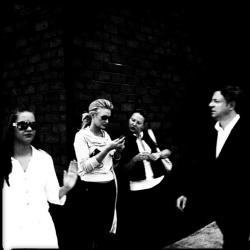
Richard Koci Hernandez.
A few blocks later, Zupan wants to demonstrate what he calls “shy distance”: how close you get to an approaching person with whom you are bound to collide before one of you shifts to the side. The process is sometimes anticipated with a kind of foreplay, what Nicholson Baker in The Mezzanine described as “the mutual bobbings you exchange with an oncoming pedestrian, as both of you lurch to indicate whether you are going to pass to the right or to the left.” Scanning the sidewalks, Zupan announces, “I’m going to find someone who’s not looking at their phone. I usually try to find someone smaller than me.” He finds his mark: an ordinary commuter in Dockers and oxford shift, striding purposefully. Zupan puts his head down, and gets to within a few feet before the man breaks right, shooting back an irritated glare. (As Zupan wrote in Urban Space, “Pedestrians have been found to take evasive action anywhere from 2 to 17 ft ahead of a stationary or moving obstacle.”)
What might be for some the unchoreographed whir of the city is for Zupan a set of discrete patterns; if a pattern can’t be observed, it probably just means you haven’t looked long enough. Block by block, they emerge: The way people drift toward the shady side of the street on hot days; the way women (in particular) avoid subway grating on the sidewalk; the way walking speeds are slower at midday than before or after work; the way people don’t like to maintain the same walking speed as a stranger next to them; the way tourists walk in inappropriately spread out groups (a phenomenon captured by this satirical call for “tourist lanes”); the way sidewalk planters, parking meters, and other obstacles reduce the “effective width” of sidewalks, which have been under slow and steady spatial assault since the early 20th century.
One place Zupan spent a lot of time during his research was Penn Station, the very place we had met that morning (where the queue at the Starbucks alone was worthy of study). During the period he was working on the book, Penn was experiencing an upsurge in ridership; the station and the surrounding streets were becoming untenable. “There were situations where it was so crowded where even slow walkers had to go slower than they would like.” When he began the research, pedestrians were still something of an unknown quantity, and indeed, his work was part of a small renaissance in pedestrian studies that flourished in the 1970s, producing works from John Fruin’s landmark—and still consulted—book Pedestrian Engineering, to sociological studies like Erving Goffman’s Relations in Public or Michael Prager’s People in Places. Every street corner was a stage-set of human interaction, no behavior too small to be insignificant. One typical study found that when two pedestrians passed closely to another, the majority of women turned away from the other walker, while the majority of men turned toward the opposing pedestrian. “We were learning by just going out in the field,” Zupan says. “If there was something we didn’t understand, we went out and took a look.”
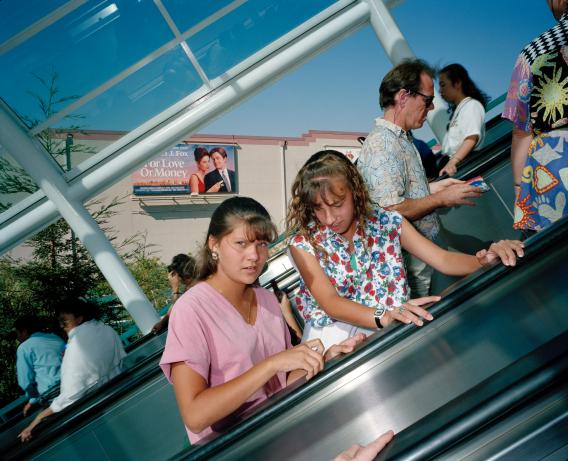
Carl De Keyzer/Magnum Photos.
For example: When do people choose to take the escalator versus the stairs? How crowded does the former have to be before the latter is chosen? Standing by a bank of short escalators and stairs exiting to Eighth Avenue, we watch a small queue form at the “up” escalator (not surprisingly, people are more likely to take stairs going down than up). What Zupan found, then as now, is that people’s desire to avoid exertion is relatively high. “To take the most extreme example, when the stairs in the subway are five flights, what’s the percentage of people who will take them?” The answer: About four percent. The people Zupan calls the “health addicts.” He adds: “I was one of them.” Contrary to what you might expect, escalators do not actually improve efficiency. “If you count the per square foot width on an escalator, plus the acceptance rate”—i.e., how willing people are to stand near each other—“it’s about the same as stairs.” And when people walk on an escalator, the capacity is, a bit counterintuitively, reduced, because of the subsequent shuffling—and accidents. (Escalator walking was actually banned in Japan.) What escalators do, simply, is reduce the amount of energy people have to exert (and during rush hours, an escalator is often the only way people are assured of being able to go against the cresting tide of directional flow).
Since Zupan’s research, a few new behaviors have come on the scene. One behavior pointed out to me by traffic engineer Sam Schwartz is people pausing before they enter the stairs of a subway station to check their mobile device one last time. Who knows what this social hiccup does to the overall efficiency? Recent research by the New York City Department of Transportation has found that when walkers talk on the phone, they walk more slowly, and when they wear headphones, they actually walk faster. As Zupan told me, “There are a lot of really microscopic dynamics—as Yogi Berra said, ‘You can see a lot just by observing.’ ”
Despite the advances of early walking-theorists like Zupan, there is a great deal of mystery and academic disputation that surrounding this fundamental human task. What’s the purpose of swinging arms, balance or propulsion? Which muscles contribute most to the body’s “angular momentum”? What part does our vision play in walking. (It was once thought we used our eyes to only plan a step, not monitor and “fine tune” its ongoing progress, but recent research suggests otherwise.)
The complexity of walking is perhaps best appreciated by those who can no longer do it, or need mechanical assistance. Alena Grabowski, a researcher at the University of Colorado who has done extensive work with prosthetic devices (including the question of whether a runner with a device has an unfair edge), says it’s not simply a question of the foot—“one of the more complex designs you’ve got,” with 20 bones in each and any number of directional possibilities. There are a number of systems that come into play. Take the knee. “The knee is challenging, there’s so much weight bearing on the leg. You need to have something that not only goes forward, but side to side, or up a hill, to catch a bus. There’s so many different things you want to model.”
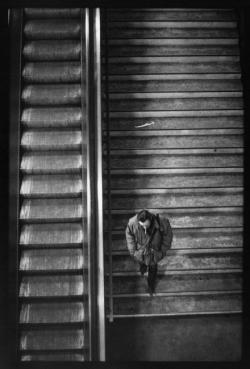
Raymond Depardon/Magnum Photos.
As Laurie Anderson once noted, when we walk, we are always falling, and then always catching ourselves. Walking is known as a “learned motor behavior,” done without conscious thought. Walking is so second-nature that even certain types of walking become ingrained. A few years ago, a pair of researchers at London’s Imperial College identified what they called the “broken escalator” phenomenon: When people walk onto an escalator that is not moving, they still sense a “sway,” and adapt their gait accordingly. The reason, the researchers argued, was not a perceptual illusion, but a “motor adaptation.” Something tickles us at the back of the brain, and our feet respond in kind.
Escalators and stairs are, it turns out, problem points in walking, and not just for the commuters at Penn Station. As John Templar notes in his oddly fascinating book The Staircase, an estimate for one U.S. year found that more than 6,000 people died as a result of a fall on stairs or a ramp. Studies have noted that most stair accidents involve either the first three or last three stairs on a flight. “On these high risk-steps,” Templar writes, “many orientation factor changes occur—route direction change, changes of view, and very large changes of illumination.” As we come to the top or bottom of a stair, we are preparing to change our gait, and we may be looking ahead to where we’re going next. We are distracted pedestrians. What’s more, when we fall, Templar notes, “our natural defense reaction systems will not help much until after we have already fallen about one step of 7 inches (18 cm).” The design of the stair and the tread plays a largely hidden, but crucial role; in one problematic staircase, the stairs were marked with lines parallel to the edge of the tread. In six weeks, 1,400 people fell on the stair: They were confusing the marked line with the actual edge of the tread.
If walking is, as one researcher describes it, a “complex dynamic task that requires the generation of whole-body angular momentum to maintain dynamic balance while performing a wide range of locomotor subtasks such as providing body support, forward propulsion and accelerating the leg into swing,” it’s no surprise that the collectivity of all this motion, coupled with the vagaries of human psychology (among other constraints) should prove such a rich field of study, demanding analytical power equal to that required at higher order institutes of physics. Pedestrians have been interviewed, tracked, modeled, asked to navigate artificial environments, and placed in wind tunnels.
Wind tunnels? Another form of pedestrian research emerging in the 1970s was the effect of tall buildings on people, and general benchmarks for urban pedestrian comfort. This was done, in part, as an ex post facto response to poor design; Minoru Yamasaki’s World Trade Center, for example, generated such ground-level gusts that, as the New York Times noted, “on certain days wind conditions at 140 West Street were so severe that pedestrians needed to hold onto ropes to allow travel.” In England, there were cases of pedestrians being killed by building-generated winds. And so people, wearing representative garments to establish “drag area” benchmarks, were trundled into the kind of wind tunnels used for aerodynamics and subjected to various gales.
The basic issue, as explained to me by Bert Blocken, a professor of Urban Physics and Building Physics at the Technical University Eindhoven (the Netherlands is the one country in the world with a “wind nuisance” standard), is that tall buildings “catch” wind. “The most intense cases are where you only have a few high rise buildings and the rest are low rise,” he says. “The tall building deviates the wind to the ground level, where it has to find its way through the network of streets.” The corners of buildings are particular trouble spots—people may not be expecting the gust as they round the corner. Architects are often not sensitive to the effect their buildings will have on people, leaving people like Blocken to come in and retrofit. In a building in Antwerp, an architect’s winning proposal featured a passageway running entirely through the building. But Blocken’s model showed it would be, in essence, a wind tunnel. In the resulting compromise, people entering the building at one end must push a button to enter the sliding doors, and, as a sign informs them, if the set at the other end of the building is open, they must wait until the other set is closed.
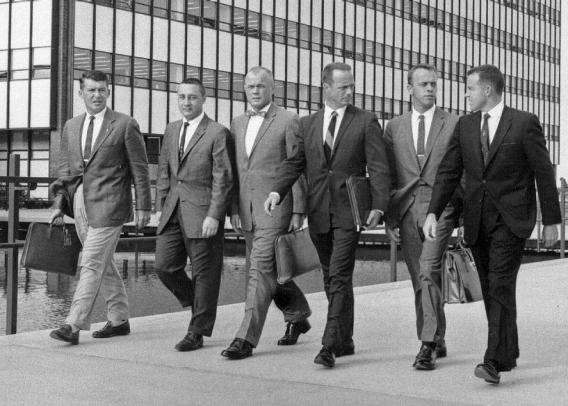
Courtesy San Diego Air and Space Museum Archive.
Since the early work of Zupan and colleagues, the body of walking knowledge has grown. We know, among other things, that nearly half of all daily walking “bouts,” as researchers dub trips, are 12 steps or fewer. It has been observed that men walk faster than women, and that walking speed is correlated to socioeconomic standing. In Copenhagen, as Jan Gehl writes in Cities for People, “on Copenhagen’s main walking street, Strøget, pedestrian traffic on cold winter days is 35 percent faster than on good summer days.” In New York, it was observed that streets with more people carrying bags had higher walking speeds. There are basic principles that have been established about group pedestrian behavior; e.g., per one study, “an individual pedestrian diverges for a group of two or more pedestrians.” As people approach a bottleneck, they tend to walk straight; as they slow to enter it, they begin to “oscillate” from side to side. There is more anecdotal research as well. As I walked one afternoon with Fred Kent, president of the Project for Public Spaces, he recalled his microscopic studies of Madison Avenue in the early 1970s, part of a project funded by National Geographic. (The street, presumably, was an exotic as a Sumatran rain forest.) “I spent one day analyzing a waste basket, another day with pickpocket detectives,” he says. He recalls talking to the owner of a small cosmetics store, which leased the front of a wig store. “I went in and asked him, you have 39,000 people going by, how do you like your location?” He was unhappy, it turned out, because he was next to a bank. “When they walk past the bank, they speed up. It takes three or four stores to get back into a normal walking rhythm.”
Much of this accumulated knowledge is now being plowed back into increasingly sophisticated computer models, which in their scope and analytical power tend to dwarf the earlier analog efforts, allowing planners to peer ever deeper into ever larger and complex crowds. One afternoon I traveled to 23rd Street to visit Legion, creators of the world’s first dedicated pedestrian modeling software. As I enter the building, I imagine myself transforming from a person on foot to—in the cold, binary eyes of Legion—a “two-dimensional ‘entity’ with a circular body, which moves in 2D continuous space, in 0.6s time step.” When I meet Dan Plottner, Legion’s (three-dimensional) vice president for business development, one of the first things he tells me is how hard it is to model people, as opposed to people in cars. “A car traveling in a lane doesn’t stop, do a 180 degree turn, and turn around and come the other way.”
At the heart of the company’s algorithms is the idea that a “person, when they walk, is seeking to minimize their dissatisfaction.” On foot, as with life itself! “The same way you can plot density on a map,” Plottner says, “you can plot frustration.” But this simple statement—minimizing dissatisfaction—explains a lot. It is why people take the escalator (and disdain elevated walkways or subterranean tunnels), it is why pedestrians will begin to rampantly jaywalk if you make them wait too long, it is why they trample “desire lines” on aloofly chained-off college quadrangles. As a British engineer once told me, “pedestrians are natural Pythagoreans”—they will always seek the shortest path.
The Legion model seeks to understand, with each step the pedestrian takes, what their next step will be, based on a mathematically weighted combination of three factors (the tolerance for, and wish to avoid, inconvenience, frustration, and discomfort). More minor things are often observed—people pausing briefly in London before exiting a transit station to see if it’s raining—but not fully modeled yet. (Plottner notes the company already has some 9 million pedestrian measurements.) Getting large crowds of people to move smoothly often involves negating people’s own natural inclinations. In London, or in Chinese cities, he notes, it is common to see a long railing at the bottom of pairs of escalators. “It forces you to take a few extra steps,” he says. “Every time we turn, we’re always trying to cut the corner, always trying to get a leg up on that other person. This removes the conflict area from the base of the escalator.” Similarly, Legion’s models for sports stadiums and other large facilities often show circular switchbacks in staircases can handle more people than square. “People are better about following the outline of the wall,” says Plottner. “They don’t feel like it’s causing them extra work.”
As cities become more crowded, with more people pushing through congested centers, Plottner says modeling becomes crucial. “When things get dense, they don’t behave in a way that makes sense,” he says. “That’s what simulation can help you unlock.” An example of this can be found at Vesey Street in lower Manhattan, between Church and West Broadway, just adjacent to the former World Trade Center site. In the morning rush, some 15,000 people per hour course down this single passage. In an effort to keep the tide from simply overwhelming the cross streets, the city has installed special fluorescent-vested “pedestrian managers,” who stretch chains across the sidewalk when the “Don’t Walk” signal is activated. When I passed by one morning and dismounted my bike, preparing to walk, I quickly gave up—with my added baggage, I simply couldn’t find an entry point among the tightly compressed torrent of commuters. “People tend to order themselves more when it’s congested,” Plottner says. “So a congested system is more efficient than an uncongested system.”
There was just one problem with Vesey: It occasionally needs to be used by trucks accessing the Trade Center construction site. Simply blocking off the street and forcing people to detour, Legion’s models showed, increased the amount of time people would have to walk by 70 percent. What about halting people temporarily while trucks entered and exited? One morning, in the offices of Sam Schwartz, a team of engineers working on the Vesey Street congestion ran through various simulations. (Schwartz uses Legion, among other tools.) On a large screen, I watched thousands of small dots swarming from the transit station, with various color-coded swirls indicating density. What the models showed is that when you held groups for upward of 90 seconds, you had “crush volumes.” At volumes of more than seven people per square meter, the engineer Jon Fruin once noted, crowds become, in essence, a liquid mass. “Shock waves can be propagated through the mass, sufficient to ... propel them distances of 3 meters or more. … People may be literally lifted out of their shoes, and have clothing torn off.”
An animation of pedestrians navigating the Vesey Street corridor near the World Trade Center construction site. The dot colors represent groups of people with different destinations. © Legion
There were actually two risks, Schwartz told me: Crush, and people backing up and toppling down the escalators. A compromise was reached: The gate to the site could be open no longer than 45 seconds (and this would be closely monitored). Morgan Whitcomb, a Schwartz engineer, told me: “We did practice runs to make sure the construction operations could time it perfectly with a truck coming in. They can do it in as little as 30 seconds.”
Modeling pedestrians works best for discrete flows in concentrated spaces, when masses of people are trying to get somewhere with purpose. “We can’t do people loitering in Times Square,” says Plottner. “We don’t understand why their behavior is what it is.” Neither do many New Yorkers, but there is something comforting in the fact that some human behaviors—pausing to admire the play of light on a 19th-century cornice, crossing the street to avoid that earnest-looking person with the clipboard, holding the door for someone at the entrance to a crowded building and finding yourself caught in a cycle of politeness as you anxiously decide when to relinquish your impromptu role as doorman—can’t easily be reduced to math.
More from this series: The troubling fact that Americans walk less than almost anybody; how Walk Score has put a number on walkability; how America can get people walking again.
Also see our Magnum Photos gallery on escalators.
